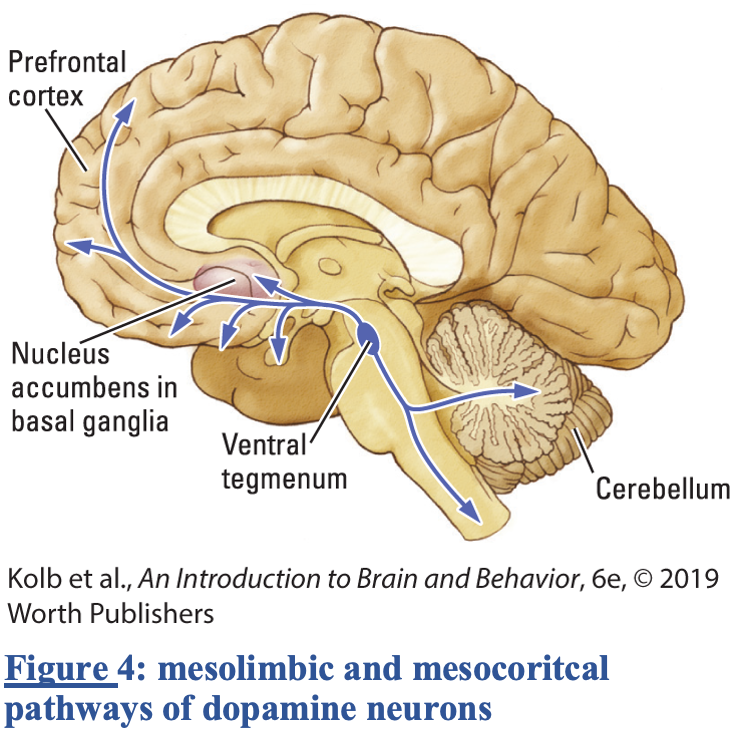Approach responses and avoidance responses
As mentioned in the previous section, two subcortical structures, in particular, are important for your students’ engagement. The activation of these structures triggers a different response: the amygdala produces an avoidance response, and the nucleus accumbens an approach response.
The amygdala and an avoidance response
When a threatening situation or event is detected, the neurons in the amygdala start firing, activating a chain reaction that results in the release of norepinephrine, a neurotransmitter and stress hormone. Norepinephrine activates the sympathetic division of the autonomic nervous system, which arouses the body for action: fight or flight. This reaction allocates all attentional resources to the threat and dealing with the situation. This phenomenon is also called amygdala hijacking because the amygdala takes over, leaving no mental space to engage with something other than the threatening situation. From an evolutionary perspective, this amygdala hijacking mechanism is vital for our survival.
The same can happen in classroom situations (Blakemore & Frith 2005:177; Churches 2017:104). When a student is – for some reason – fearful or anxious, he or she will not be able to engage optimally with the learning opportunities in your classes. The student cannot attend to the learning opportunity because the amygdala affects the working memory system, located in the lateral prefrontal cortex (LPFC). The fear or anxiety limits the access to working memory, and the student will have difficulty holding or manipulating information. As we will see in the module on attention/concentration, working memory is also a component of the attention network in the brain. The student will also struggle to maintain his or her attentional focus.
As such, these negative emotions and feelings prevent the student from engaging in learning. In addition, a study by Luria et al. (2021) has shown that punishment also activates the amygdala, resulting in avoiding a learning opportunity.
Finally, research has shown that the amygdala shows heightened sensitivity to emotional stimuli during adolescence and emerging adulthood (Sato et al. 2008). Therefore, fostering a positive learning climate in your class in which students feel safe is crucial.
- Explain in your own words what an avoidance response is.
- How and why does an avoidance response effect learning?
- What actions might have caused an avoidance response during your classes?
The reward system and an approach response
Reward, or better the anticipation of reward, activates the nucleus accumbens, a subcortical structure that is part of the brain’s reward system (Galvan, 2018:151-178; Kolb et al., 2019:431-434; Gazzaniga et al., 2019:50; Ward, 2020:432-433). The reward system is essential for our desire to approach and experience the world around us and the opportunities it offers us. When something is rewarding, we are more eager to undertake it or walk the extra mile. The concept ‘reward’ should be interpreted here in a broad sense: receiving money, earning points, tasty food, but also achieving a goal, mastering something, praise, gratification, etc.
Animals engage in a wide range of voluntary behaviors because those behaviors are rewarding That is, these behaviors increase the activity in neural circuits that function to maintain an animal’s contact with certain environmental stimuli, either in the present or in the future. Presumably, the animal perceives the activity of these circuits as pleasant. This conclusion would explain why reward can help maintain not only adaptive behaviors (…), but also potentially non adaptive behaviors. – Kolb et al. (2019:431)
An important neurotransmitter in the reward system circuitry is dopamine. The axons of the dopaminergic neurons located in the brainstem (ventral tegmental area) spread throughout the entire brain (see Figure 4), thereby modulating multiple brain functions such as movement, addiction, reward, mood and memory. More specific, dopamine seems to intensify the activity in a neural network (Gazzaniga et al., 2019:533-537). However, recent research shows that dopamine responses vary among people, and different students will react differently to rewards. So, there is no one size fits all.
The reward system and learning
Reward, or better the anticipation of reward, activates the nucleus accumbens, a subcortical structure that is part of the brain’s reward system (Galvan, 2018:151-178; Kolb et al., 2019:431-434; Gazzaniga et al., 2019:50; Ward, 2020:432-433). The reward system is essential for our desire to approach and experience the world around us and the opportunities it offers us. When something is rewarding, we are more eager to undertake it or walk the extra mile. The concept ‘reward’ should be interpreted here in a broad sense: receiving money, earning points, tasty food, but also achieving a goal, mastering something, praise, gratification, etc.
What exactly happens in our brain? When a learning opportunity is expected to be rewarding or beneficial in some way, it activates the dopaminergic neurons in the reward system network. As a consequence, we become more engaged in the learning experience. The dopamine released by the dopaminergic neurons intensifies activity in neural networks, thereby reinforcing the learning in which we are engaged. The activation of the reward system also boosts our attentional networks. When we are interested in and engaged with a learning experience, we are more eager to pay attention to this experience. As we will see in the next module, directing our attention is also important for learning and facilitates better memory formation.
The expectation of reward thus creates an approach response and motivates us to engage more with the learning opportunity. Therefore, teachers need to elicit approach responses.
- Explain in your own words why rewards are important and produce an approach response.
- Why and how is the reward system important for learning?
- What actions might have caused an approach response or activation of the reward system during your classes?




